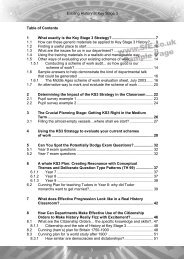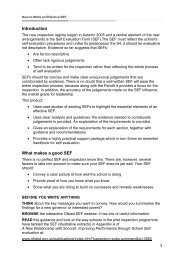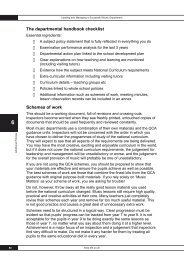PRINTING TECHNOLOGY ●●PRINTING TECHNOLOGYDirect Digital PrintingDirect Digital printing (DDP) has been heralded widely as the next technicalleap in the textiles printing industry, and the technology used is anextension of the technical revolution that is taking place in other industries.What is DDP?DDP is printing technology,The Backgroundwhich allows a design toHistorically, textile printing has been executed using a transferring medium, suchbe printed directly ontoas screens or rollers. Each transferring medium is engraved and assigned tofabric, from a computer,each specific colour.using an inkjet printer.As a result of recentBlock printing and engraved copper printing are the early examples of theseDDP courtesy of Sophisdevelopments in inkmethods. In block printing, the number of colours in the design is represented bychemistry, almost everytype of fabric can bedigitally printed usingink-jet technology.■ DDP allows the user toscan in pictures,artwork, and just aboutanything else and printit onto fabric.■ DDP allows amanufacturer to printunlimited colours,unlimited size repeatsand achieve a qualityunobtainable ontraditional rotarymachines. It alsoeliminates the need toengrave expensivenickel screens.a number of carved wooden blocks. A different block is needed for each of thecolour separations and these mainly consist of flat silhouette shapes and a threedimensional effect is obtained by printing several layers of these flat shapes.Historically, engraved roller printing consisted of lines and dots engraved oncopper surfaces as in intaglio printing. These early methods created the finestquality of detailed lines and tonal effects, which are still the goals for today’sprinting technology.AS A RESULT OF RECENTDEVELOPMENTS IN INKCHEMISTRY, ALMOST EVERYTYPE OF FABRIC CAN BEDIGITALLY PRINTED USINGINK-JET TECHNOLOGY.The Challengesfacing DDPAs little as 15 years ago,achieving digitally printedtextiles with a qualitymatching that producedconventionally looked likemission impossible. Thedemands of the textileapplication are extreme.Among them:■ more than a half dozencommon types ofsynthetic and naturalfibres, each with itsown ink compatibilitycharacteristics■ dealing with astretchable, flexible,often highly porous and■ extreme userequirements includinglight and water fastness(including sweatfastness) throughfinishing operations andoften outdoor use,heavy wear, abrasion,and cleaning■ for some apparelapplications,challenging registrationrequirements sinceseparate pieces needto be assembled■ not just sight, but alsotouch requirement■ much greaterabsorbency, requiringmany times the inkvolume compared withThe Benefits of DDP■ There are no limits onprintable colours orrepeat size■ Sampling time issignificantly reduced■ Multiple colourways canbe created in minutes,with the click of a mouse■ Screen costs arereduced■ Reduced labour costson short run productionThe key advantage to amanufacture is one oftime. Designers can seeDDP samples in a matterof hours, instead ofwaiting weeks for screensto be engraved andtextured surfacesprinting on papersContinued overleaf…just 4Textiles ■ ISSUE 1 SUMMER 2003 just 4Textiles ■ ISSUE 1 SUMMER 200322 23
PRINTING TECHNOLOGY ●●PRINTING TECHNOLOGYDirect Digital PrintingContinued from previous page…design struck. Similarlywhen producing multicolourways, designers cansee the effect of thescreen run order on theoverall pattern.The Limitationsof DDP■ The speed of printing ismuch slower than arotary machine, at 5metres per hour■ Fabric widths are limitedto 150 centimetres■ The fabric needs to betreated prior to printing■ The cost per metre ishigher than the currentrotary process.New RetailingOpportunitiesDigital printing opens thedoor for new retailingopportunities to markethigh quality, one-off shortruns. While the currentprices for these specialtyfabrics are quite high, themarket has discoveredthere are discerningconsumers who are willingto pay for the opportunityto have not only what theywant, but something that istruly unique.While the use of digitaltextile printing for samplesand strike-offs hasdramatically reduced theturnaround time from thetraditional six to eightweeks to just a few days, oreven hours, it is in the areaof mass customization thatthis technology holds thebrightest future. Alsodefined as agilemanufacturing, masscustomisation leverages theuse of technology againsta mix of pre-definedstandardized componentsand allows the customer tobuild their own product.An established market thatis well suited for this typeof strategy is the homefurnishings/linens market.Traditionally manufacturerswere forced to carry atremendous inventory ofboth print patterns andsewn bed products. Now amass customizationbusiness mode, deployingdigital textile printing, willallow the manufacturers toinventory white goods only,and print, cut and sew asthe market demands. Aprint style will conceivablynever be obsolete, and theconsumer will be able toorder replacement piecesat any time.THE FUTURE OF DIGITALPRINTING TECHNOLOGYIS NOT JUST ABOUTREPLACING EXISTING PRINTINGMETHODS WITH DIGITALPRINTING TECHNOLOGY, BUTABOUT NEW PRODUCTS,NEW MARKETS AND NEWOPPORTUNITIES.SophisFor more than a decade, the Sophis Group, a 20-year-old Belgian company, has supplied itsdesign and weaving software system to thetextiles industry. In addition to its textile designfeatures, the software can link to the loom itself,controlling how the device lifts threads and shiftsthe yarn. Sophis predicts that digital printing willeventually eliminate textile manufacturers’resistance to short-run orders. This is becausethanks to digital print technology, short runs willactually become easier to handle than longerruns. In turn, digital printing will drastically reducethe number of rotary printer screens that textilecompanies need to produce, as well as enhancedesign variation and complexity. During customervisits, small fabric samples will be whipped off ofthe printer in a matter of minutes, and rapidprototyping of colourways will accelerate theprocess from design to manufacture.Glossary of Printing TermsAcid dyes:Discharge Printing:Commercial dyes used for Method of printing withnylon, wool, silk, acrylic, chlorine or other colordestroyingchemicals on apolypropylene and blends ofthese fibres, so called because fabric already dyed to bleachthey are applied to fabric in out the color, yielding a whiteorganic or inorganic acid pattern on a colored ground.dyeing solutions.Dye Sublimation:Blotch Printing:A loss of dye due to evaporationMethod of printing in which of the solid without formationthe ground color is printed of a liquid phase.rather than dyed; the reverse ofthe fabric is white.Fixing/Fixation:Method of setting the dye afterColor Fastness:dyeing, usually by steaming,Term used to denote the hot wash, or chemicals.resistance to change of amaterial in any of its colour Heat Transfer Printing:characteristics. (Usually refers A method to transfer designsto a dye’s permanence after from rolls of paper to fabrics.washing, exposure to light, etc.) Designs are preprinted on thepaper with disperse dyes thatDigital Printing:sublime onto fabric when theyA form of printing where are brought together at 400°Fmicro-sized droplets of dye are (204°C) in a heat transferplaced onto the desired printing machine; mostsubstrate through an inkjet effective on polyester andprinthead. The print system cellulose triacetate; blends withsoftware interprets the data cellulosic and animal fibres tosupplied by a digital image file produce pale effects.to control the droplet outputso that the image quality and Misfits:color control may be achieved. A misfit is a print defect causedby improper alignment of theDisperse Dyes:screens. Also known as ‘out ofSynthetic, almost waterinsoluabledyes used for acetate, unprinted areas in the design.registration,’ misfits leavenylon and polyester, applied For example, a green leaf mayfrom fine aqueous solutions. overlap its black outline or printover another color. Up to 10%of printed goods designated asfirst quality contain some levelof misfit.Pigment Dyes:Insoluble pigments are printedonto fabric with binders oradhesive resins, and theprinted fabric is then heatedto fix the binder and renderit insoluble.Reactive Dyes:Class of dye which reactschemically to bond with thefibre substrate. Application ismostly limited to cellulosic,protein, and nylon fibres. Colorsare bright; fastness excellent.Rotary Screen Printing:A technique for printing thatutilizes perforated nickelscreens shaped into hollowcylinders. A screen is preparedwith the pattern for each colorin the design. A metal rollerforces the color paste onto thefabric wherever the holes in thescreen have not been covered.Particularly suited to makingblotch prints. (This is themethod used for mostcommercial screen printedfabrics for apparel.)Substrate: In textiles, a fibreassembly, yarn, fabric orfilm to which another materialis applied.Stick-ins:A stick-in occurs when a smallfibre or piece of lint gets stuckin the screen opening. Theresult is a small pen tip sizedunprinted circle in the design.A stick-in is very difficult tosee and often goes unnoticedduring a long run.Scrimps:A scrimp defect occurs whenthe fabric creases underneathone of the screens during theprinting process. The pattern isthen printed on top of thecrease, leaving a largeunprinted area when the fabricreturns to its relaxed state.Wicking:Wicking, also known asflushing, occurs when theprinted area bleeds out intothe unprinted area. The resultis a ‘haloing’ or shadowingeffect around the outline ofthe pattern design. Residualsalts left in the fabric duringresin finishing and/or poorfabric preparation oftencause wicking.just 4Textiles ■ ISSUE 1 SUMMER 2003just 4Textiles ■ ISSUE 1 SUMMER 200324 25








